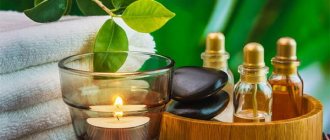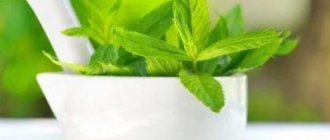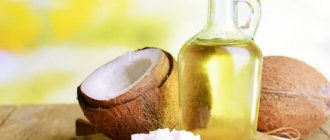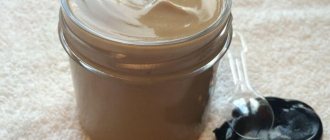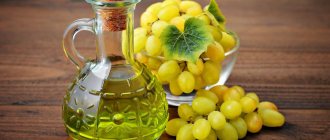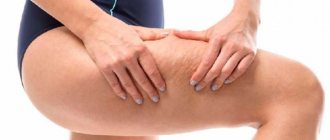Massage oils: types and rules of use
Why do you need massage oil ↑
According to statistics, 5% of massage therapists do not use products to improve the glide of their hands over the client’s skin or use talc. The remaining 95% use massage oils and oil mixtures. And they are right in their choice.
Massage oils are used for:
- improving the gliding of the massage therapist's hands
- providing additional effect. During the massage process they can be used to combat cellulite and stretch marks, excess weight, have a warming, nourishing, cooling, moisturizing, relaxing, toning, anti-stress effect on the skin and the body, ideal for increasing body elasticity.
The use of oils makes it possible to protect the skin from stretching, irritation, and damage to the upper layer of the epidermis due to active and prolonged mechanical action.
But the main thing is that the natural products used saturate the skin with valuable components that help maintain its youth and elasticity.
Basic and essential oils: the difference ↑
Based on such a wide functional spectrum, natural cosmetic oils are divided into:
- Basic (bold). Their main function is to ensure the sliding of the massage therapist’s hands.
- Active (essential). Used to enhance or direct the effect of massage.
In order for the use of such products to be as effective as possible, it is necessary to understand the capabilities of each type and the textural characteristics.
Basic ones are obtained from seeds, nuts and grains of various plants. They do not have pronounced aroma characteristics. They are used as a basis for products that are applied to the skin during massage.
Essential oils are volatile compounds without glycerin. They have a pronounced aroma and high concentration, so they cannot be applied to the skin in its pure form. The exception is tea tree oil, patchouli and lavender, but they are also not recommended for massage without impurities.
Essential oils are differentiated by the method of production, by the part of the plant, by the degree of naturalness, by the notes, and by the effect on the body. It is the latter characteristic that is of particular importance when used for massage. It is necessary to clearly understand which product is suitable for dry skin, which one is suitable for oily skin, and so on.
DIY anti-cellulite massage
If you don’t want to bother so much at all, but still want to get rid of cellulite, then try the following massage with a dry brush on a dry body. Anti-cellulite oil or any other product will need to be applied to the skin after the massage. This can be done on damp skin immediately after a shower or immediately after a massage on a body that is still heated by a dry massage. In the latter case, it is still better to use anti-cellulite cream, since pure oil applied to dry skin will not have the desired effect and, moreover, can dry out the skin of the body.
As for the not very pleasant sensations that accompany such a massage, you quickly get used to them and they even become quite pleasant.
0
How to choose the right base oil ↑
- Base oils are sold in liquid and solid form. The batters are used for massage tiles, and when melted, for manual body massage. Liquid substances can be unrefined or refined. The former are more valued in cosmetology. The most beneficial substances are those extracted using cold-pressed technology.
- Basic massage products contain a large amount of minerals, vitamins, and polyunsaturated fatty acids. They affect metabolic processes at the cellular level, the intensity of cell regeneration, have an antioxidant effect, and stimulate metabolism.
- The choice of the base product plays a lesser role than the essential one, but not the least. Such a product should not only provide excellent glide over the skin, but also spread well, be quickly absorbed and not leave a greasy residue.
- It should not be too dense in structure. For different types of dermis, you need to use different basic massage oil products. An important characteristic is the degree of blockage of the sebaceous ducts (comedogenicity).
- When purchasing, be guided by the label “unrefined, first cold pressed.”
How to do
The massage uses both pure base oils and compositions of natural vegetable and essential oils. Rubbing an aromatic product into the skin enhances the massage effect and increases the rate of oxygen penetration into cells. If your goal is healthy skin, then you can make your own massage oil with the addition of various essential oils. These active ingredients, depending on the type, have a tonic, relaxing and nourishing effect on the skin. Most essential oils smooth the surface of the skin, improve its elasticity and firmness. The recipe for making massage oil with your own hands is selected depending on your goals. Ylang-ylang, sandalwood and bergamot in combination with any base oil are perfect for eliminating muscle tension; orange, juniper and grapefruit with a base of grape seed oil are ideal for eliminating cellulite. When using oil mixtures, allergic reactions may occur, so be sure to conduct a sensitivity test before the procedure.
If you are going to make massage oil with your own hands for every day, then use low concentration components, while reducing the amount of essential oil by half. The massage oil recipe assumes the following proportions - for every 10-15 ml of base oil heated in a water bath, in total there are no more than 7-10 drops of essential oils. The prepared mixture should not be stored for a long time. But if you still need to preserve the oil, then place it in a dark glass vessel with a tight lid and place it in a dark place.
Main types of base oils ↑
We have compiled for you a list of basic oils for body massage, taking into account their main characteristics.
According to their ability to clog pores, they are:
- Camedogenic: cocoa, peach, almond, flaxseed, corn, coconut, castor, peanut, sunflower, shea, safflower, cottonseed, jojoba. They are best used for mixtures.
- Do not clog pores: wheat sprouts, hazelnuts, apricot and grape seeds, kukui, sesame seeds, poppy seeds, rice.
By impact on different types and species:
- Moisturizing for dry skin: evening primrose, olive, almond, sesame, wheat germ, avocado, apricot kernels.
- For oily skin: jojoba and grape seeds.
- For all skin types (dry, oily and combination): you can add safflower and sunflower oils to those listed above.
- For dry, sunburned skin: St. John's wort, coconut and avocado.
- For sensitive and very thin body skin, for its elasticity: apricot kernels and almonds.
- For itchy body skin: wheat germ, calendula, coconut, almond, olive.
- For a fading body, increasing its elasticity: evening primrose, apricot kernels, avocado, almonds, wheat germ.
The most common base oils ↑
Coconut
Coconut – odorless, easily absorbed, hypoallergenic. Creates a protective barrier on the surface of the dermis and on the hair shaft from the negative effects of environmental factors. Often used to moisturize chapped and dry skin on the body. It should be used in refined form, avoiding the neck and face area.
Jojoba
Jojoba – does not leave an oily sheen, is odorless, suitable for all skin types, and for strengthening hair. It cannot be used in its pure form.
Apricot kernel
Apricot kernels – has a pleasant light aroma and perfectly tones. Suitable for combating cellulite, wrinkles, and for baby massage. Can be used in any mixture.
Almond
Almond – can be used to massage the body and face, not excluding the area around the eyes. Used to treat cellulite, has a warming effect.
Macadami
Macadami is hypoallergenic (except for nut allergies), used for facial and body skin care during the cold season. An excellent smoothing and moisturizing product for dry skin.
Shea butter
Shea butter (shea) - used for mature skin and in the fight against cellulite and stretch marks. Has a warming and protective effect. It cannot be used in its pure form; its maximum part in the mixture is 10%.
Olive
Olive – helps with joint pain, nourishes and moisturizes the skin, improves tanning. It is not recommended to use it in its pure form.
sunflower oil for massage
I found this on the Internet, maybe it will be useful to someone... Perineal massage during pregnancy Childbirth is a very important and crucial moment in a woman’s life. And every woman wants the risk of complications not only for the child, but also for herself, to be minimized. But often, when preparing for childbirth, women forget about themselves and think only about the baby. One of the unpleasant consequences after childbirth can be a scar after a rupture or episiotomy of the perineum. To avoid such “accidents”, it is necessary to massage the perineum during pregnancy. Massage itself has a beneficial effect on internal organs, improves blood circulation and normalizes the nervous system. And perineal massage during pregnancy is also one of the main components in preparing for childbirth. Perineum The perineum is the pelvic floor muscles. The area of its location is between the vagina and the anus. During childbirth, during the period of pushing, the baby's head drops to the pelvic floor and stretches the muscles of the perineum. The woman pushes and helps herself push out the baby with these muscles. Therefore, the perineum experiences enormous stress during childbirth, and any careless movement on the part of the woman in labor or incorrect care provided by the midwife can lead to ruptures. Also, the frequency of episiotomies and ruptures is influenced by: hereditary predisposition, constitutional characteristics, weight and presentation of the fetus, tissue elasticity (in primiparous women, the perineal tissue is inflexible). Perineal massage during pregnancy can reduce the likelihood of cuts and tears. Perineal massage for pregnant women and rules for its implementation In order to achieve good elasticity of the perineum, several rules must be followed: • massage must be performed regularly; • before performing a massage, empty your intestines and bladder; • it is useful to take a warm bath or shower before a massage session (softens and relaxes the perineal tissue); • the massage therapist's hands must be thoroughly washed, nails must be cut short; • mandatory use of sterile or fire-heated oil; • use of sterile medical gloves if the skin and mucous membranes are hypersensitive. Perineal massage for pregnant women: technique Perineal massage can be carried out either by yourself or by involving your husband in this process. In the later stages of pregnancy, a woman is hampered by a large belly, and self-massage does not allow her to achieve the maximum degree of relaxation, which is very important for future childbirth. This relaxation becomes automatic and helps the woman in labor relax during contractions. The optimal position during the massage is: lying on your back, placing a small pillow under your lower back, or half-sitting (if the husband is doing the massage), or placing one leg on the edge of a chair (bath). At first, during a self-massage session, it is convenient to use a mirror to see the perineal area. Before starting the massage, you need to generously pour oil from a bottle onto your fingers (constantly dipping your fingers into a container of oil leads to contamination and risk of infection). You should also lubricate the skin of the perineum and the third of the vagina closest to the exit with oil. Then carefully, shallowly (3-4 cm) insert one finger (thumb or index) into the vagina and make pressing movements on the back wall of the vagina and to the sides, as if stretching it, until a feeling of tension and tingling occurs. Hold in this position for 45-60 seconds and release. After some time, repeat. You need to continue the movements for 5-7 minutes. Then you need to begin rhythmic movements in the vagina, then speeding up, then slowing them down, followed by moving to the perineum towards the anus and back for three minutes. The movements should be gentle and at the same time slightly pressing. After the massage procedure, you can apply a warm heating pad to the perineum for 30-60 minutes, this will soften the tissues and enhance the effect of the massage. If massage is performed on first-time mothers or women who are actively involved in sports (gymnastics, aerobics, dancing), then the massaging movements should be more intense. What oils can be used for massage Nowadays, pharmacies offer a fairly wide selection of sterile oils. They are affordable for every pregnant woman: • rose oil; • chamomile oil; • calendula oil; • olive oil; • sprouted wheat oil; • you can use sunflower oil by boiling it first; You should not use castor oil, it stimulates the contractile activity of the uterus. Contraindications for massage There are several restrictions when perineal massage and pregnancy are incompatible. Firstly, these are all infectious and inflammatory diseases of the vagina (bacterial vaginosis, thrush and other colpitis). First you need to treat the inflammation, then massage. Otherwise, the massage will not bring benefit, but harm, spreading the infection deep into the vagina, onto the cervix and into the amniotic fluid. Secondly, the tendency to threaten abortion. Thirdly, in the presence of skin diseases that involve the perineum in the process, and with an increase in temperature. Terms of pregnancy and perineal massage As noted above, perineal massage can be started at any stage, the main thing is its regularity: • for a short period of time, massage is carried out once every 7-10 days; • from 28 weeks, massage is carried out once every 5-7 days; • from 32 weeks, massage must be done once every 3-5 days; • from the 36th week - every other day; • starting from the 38th week - daily.
Essential oils for massage ↑
When compiling a set of essential oils, rely on the following characteristics:
- Naturalness.
- The presence of aromatherapy effect.
- Strong psychological and energetic effects.
- Healing, anti-inflammatory, antiseptic and stimulating properties.
- The ability to have different types of effects on the body.
Essential oils have a more specific purpose in the process of body massage. Correct use and dosage of active oils can improve the effect of the procedure several times, and has a beneficial effect on the psycho-emotional state. Due to their molecular structure, the substances penetrate the skin and have a therapeutic effect within 20 minutes after application and for a long time.
Essential oil should be added to the base oil immediately before the massage. To activate it, the mixture must be stirred well and heated to a temperature of 40 degrees.
The ratio of oils in the massage mixture should be no more than 12 drops of essential oil per 8 teaspoons of the base composition.
To begin with, we recommend using one type of active oil in the mixture. Over time, you will learn to create mixtures based on the desired effect of the massage.
Essential oil categories
- The top note is volatile oils with a strong aroma that quickly evaporate and are absorbed into the skin. Examples of top notes include lemon, mint, eucalyptus and basil oils.
- The middle note is heavy, sticky and less aromatic oils that have a more delicate and long-lasting scent, such as marjoram, sage, anise and thyme.
- The base note is the harmonizing agents that unite the mixture into a whole; usually have a long-lasting aroma like amyris, sandalwood, frankincense and myrrh.
Each recipe lists the oils in the order and quantity in which they should be added to the base oil, although this is just the beginning. Essential oils may vary depending on many factors. Therefore, you may want to experiment with your mixtures in small quantities until you get what you want.
List of essential oils for massage ↑
Essential oils affect our body in different ways.
- For relaxation, use the following plant oils: mint, lavender, sage.
- For pain relief: mint, lemon balm, pine, fir.
- To increase libido: rose, ylang-ylang, ginger, sandalwood, neroli.
- To stimulate brain activity: black pepper, bay, fennel, cinnamon, basil, geranium, bergamot.
- For sports massage: sage, mint.
- Against cellulite: citrus fruits, bergamot, rosemary, juniper, geranium, cypress, patchouli, fennel.
- For dry skin of the body and face: orange, ylang-ylang, chamomile, neroli, sandalwood.
- For oily and problematic skin: grapefruit, juniper, tea tree.
- Against stretch marks: lavender, rosemary, mint, cloves.
- For problematic and dry skin of the hands and strengthening nails: thyme, lemon, lavender, eucalyptus, chamomile, patchouli.
- For dry scalp and hair: sandalwood, ylang-ylang, rosemary, orange.
- For oily hair: cedar, lemon, cypress.
- To slow down the aging process of the body: chamomile, cajuput, patchouli.
General recommendations ↑
In order to unlock the full potential of oils, we recommend that you listen to the general recommendations for carrying out this procedure:
- The same product, for example for dry skin, can have different effects on people. Therefore, in the process it is necessary to monitor the psycho-emotional state of a person.
- For body massage, it is better to use homemade mixtures, since ready-made products most often contain artificial flavors and oils of inorganic origin.
- When performing self-massage, use your acquired knowledge, you can take a training course. Using a randomly composed oil mixture can be harmful to health.
- Don't use too much product. It should not spread in drops. The amount should be sufficient to cover the surface to be massaged.
- For aroma massage, you need to use oils, relying not only on their effect, but also on the client’s personal preferences. If the smell is unpleasant, no matter how healing the remedy is, it will have a negative effect.
- Massage should be given at least 30 minutes a day. Sessions should be carried out at least once a week, and preferably daily.
Body massage should be used in the cold season to protect and moisturize dry skin, in hot weather - to protect against UV radiation and nourishment, in adulthood - to maintain youth, in youth - to improve health and enrich the body with vitamins and minerals.
Massage can become a pleasant and useful habit at any age; it can act as a type of aromatherapy and even meditation.
A massage using various oil mixtures will help you lift your mood, improve your health, strengthen your immune system, get rid of cellulite and age spots, and maintain the elasticity and youth of your body.
How to replace body massage oil?
For body massage you can use:
- Cream. A thick, rich cream is suitable for massage. It will give your hands good gliding and make the process very pleasant. Children's cream is perfect - a budget and high-quality option.
You should not choose a moisturizing cream for body massage, as it is absorbed very quickly. This will significantly reduce the duration of the procedure.
- Vazilin. Another excellent option is Vasiline, since it also ensures the massage therapist’s hands glide and softens the skin.
- Olive oil. The best choice for home massage. Not only provides comfort, but also makes the skin soft and velvety.
But it is important to apply a small amount of oil to the body so that it does not spread and spoil the bed linen.
An interesting massage product is honey . To use it for massage, you need to melt it in a water bath until it becomes semi-liquid. No additional ingredients required. Honey softens the skin, gives elasticity, smooths out wrinkles, rejuvenates, cleanses of rough skin particles, and stimulates blood circulation.



